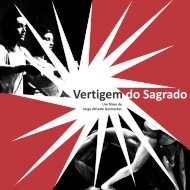A GRANDE REFAZENDA
- No tags were found...
You also want an ePaper? Increase the reach of your titles
YUMPU automatically turns print PDFs into web optimized ePapers that Google loves.
10 A Grande Refazenda, África e Diáspora Pós II CIAD<br />
A Grande Refazenda<br />
The Great Revival<br />
In the appendix there is a chosen sample of<br />
press registers from CIAD II and CIAD Cultural<br />
reflecting the importance and expectations of the<br />
consequences and of the events protagonized by<br />
their participants, which is expressed very well in<br />
The Salvador Declaration, the conclusive text, also<br />
included in this publication.<br />
Besides the written words, the images from<br />
CIAD II and CIAD Cultural captured by the cameras<br />
of Edson Ruiz and Júnior Esteves, perpetuate the<br />
gathering of diversity, the effort towards the interaction<br />
of peoples and nations, and the celebration of<br />
Africanness.<br />
Returning to the themes and proposals discussed<br />
at CIAD II and the lively expression of what the poet<br />
José Carlos Capinam defines as the ways of knowing<br />
and doing raised by CIAD Cultural, The Great Revival:<br />
Africa and the Diaspora Post-CIAD II is, at the<br />
same time, a documentary register of this unique<br />
moment in the history of the relationships among<br />
peoples, a broad reflection of the reality of the<br />
contemporary world and, principally, a reaffirmation<br />
that the inclusion of Africa and diasporic peoples in<br />
the process of development, is not only possible, but<br />
also inevitable.<br />
*Waldomiro Júnior is a journalist, General Secretary of the<br />
Mário Gusmão Study Center (CEMAG), [and] coordinator of<br />
the editorial project The Great Revival: Africa and Diaspora<br />
Post-CIAD II.<br />
dos pelos seus participantes, tão bem traduzidos na Declaração<br />
de Salvador, o texto conclusivo, também incluído nesta publicação.<br />
Além das palavras escritas, as imagens da CIAD e do CIAD<br />
Cultural, captadas pelas câmeras de Edson Ruiz e Júnior Esteves,<br />
perpetuam o congressamento da diversidade, o esforço<br />
pela interatividade entre povos e nações e a celebração da<br />
africanidade.<br />
Ao resgatar os temas e propostas discutidas na II CIAD e a<br />
expressão viva do que poeta José Carlos Capinam define como<br />
saberes, sentires e fazeres, trazidos pelo CIAD CULTURAL, A<br />
Grande Refazenda – África e Diáspora Pós II CIAD é ao mesmo<br />
tempo, um registro documental desse momento único na história<br />
das relações entre povos, uma ampla reflexão sobre a realidade<br />
do mundo contemporâneo, e, principalmente, uma reafirmação<br />
de que a inclusão da África e povos diásporos no processo de<br />
desenvolvimento, não é apenas possível, mas também inevitável.<br />
*Waldomiro Júnior – jornalista, secretário-geral do Centro de Estudos Mário Gusmão (Cemag), coordenador<br />
do projeto editorial A Grande Refazenda – África e Diáspora Pós II CIAD<br />
Gilberto Gil*<br />
Ao longo de 50 anos de lutas contra o colonialismo, pelas<br />
independências nacionais e contra o sistema do apartheid<br />
outrora instalado no coração da África, africanos e afro-descendentes<br />
estiveram unidos pela bandeira da libertação.<br />
Hoje, depois de tantas lutas e guerras, é preciso reconstruir as<br />
economias, recompor solidariedades, consolidar as nacionalidades<br />
e, ao mesmo tempo, estabelecer um novo relacionamento<br />
econômico com um sistema mundial globalizado. A própria<br />
transformação da OUA-Organização da Unidade Africana em<br />
UA-União Africana, é o sinal destes novos tempos de renascimento<br />
africano.<br />
Para responder a este grande desafio da contemporaneidade,<br />
todos os filhos da África são chamados. Do lado ocidental<br />
do Atlântico, atenderam ao chamado os descendentes de<br />
africanos, constituintes de diversos países americanos e caribenhos.<br />
Marcados todos pela história colonial da escravidão<br />
e pela sobrevivência posterior em sistemas de subalternização<br />
social e econômica, fizeram emergir as lutas pela reparação das<br />
perdas do passado e pela criação de mecanismos de igualdade<br />
que promovam o acesso pleno à cidadania e ao bem-estar. A<br />
rigor, os protagonismos negros libertários produziram um caleidoscópio<br />
de experiências ambientadas nas circunstâncias de<br />
cada sociedade. E assim construíram novas Áfricas.<br />
A predominância nesses mundos negros de uma grande<br />
diversidade de projetos não produziu uma Torre de Babel exatamente<br />
porque não predominou a lógica materialista da sociologia<br />
européia, seja a de Durkheim, seja a de Marx, pela qual<br />
os interesses objetivos soldariam as solidariedades de grupo ou<br />
de classe. O cimento era outro. Acredito que nossas solidariedades<br />
sempre foram uma expressão de nossas identidades que<br />
vicejaram em uma cultura afro-global, o que significa dizer que<br />
as representações que construímos de nós mesmos foram mais<br />
fortes do que as condições de exploração e de pobreza a que<br />
fomos submetidos.<br />
Para melhor entendermos este processo, é necessário fazer<br />
uma remissão histórica às características especiais da diáspora<br />
africana que formou as Américas. Ela se deu, a partir do<br />
século XV, no bojo de um processo de expansão européia e de<br />
mundialização do capitalismo. Um processo mundializado de<br />
acumulação de riquezas para a Europa requeria o reordenamento<br />
de outras populações para as tarefas produtivas no novo<br />
mundo, na condição de força de trabalho. Mas quem eram estes<br />
outros? Eram exatamente aqueles não cristãos e, portanto,<br />
Gilberto Gil*<br />
Throughout the fifty years of struggle against colonialism,<br />
for national independence and, at another<br />
moment, against the system of Apartheid installed in<br />
the heart of Africa, Africans and those of African descent<br />
were united under the flag of liberation. Today,<br />
after so many struggles and wars, it is necessary to<br />
reconstruct economies, reaffirm solidarities, consolidate<br />
nationalities, and, at the same time, establish a<br />
new economic relationship in a worldwide, globalized<br />
system. The very transformation of OAU--Organization<br />
for African Unity--into the AU--African Union--is<br />
a sign of these new times of African Renaissance.<br />
In order to respond to this great contemporary<br />
challenge, all of Africa’s offspring are summoned.<br />
From the western side of the Atlantic, those of African<br />
descent, from various American and Caribbean<br />
countries, answer the call. All marked by the colonial<br />
history of chattel slavery and by the later survival of<br />
dehumanizing social and economic systems, they<br />
made the birth of struggles for the reparation of losses<br />
in the past and the creation of mechanisms of equality<br />
that promoted full access to citizenship and well-being<br />
possible. More to the point, set in the given circumstances<br />
of their societies, Black freedom-bent activities<br />
produced a kaleidoscope of experiences. And in this<br />
way, they constructed new Africas.<br />
The predominance of these Black worlds of widely<br />
diverse projects did not produce a Tower of Babel precisely<br />
because European sociology’s idea of materialist<br />
logic, whether it be the school of Durkheim or Marx<br />
where objective interests motivate the allegiances of<br />
a group or class did not prevail. The cement was different.<br />
I believe that our allegiances were always an<br />
expression of our identities that flourished in a global<br />
Afro-culture, which is to say, the representations of<br />
ourselves that we constructed were stronger than the<br />
conditions of exploitation and of poverty to which we<br />
were subjected.<br />
In order for us to better understand this process,<br />
it is necessary to historically cross-reference the<br />
special characteristics of the African Diaspora that<br />
formed the Americas. Since the fifteenth century, the<br />
African Diaspora has became the staging ground for<br />
a process of European expansion and the worldwide<br />
spreading of Capitalism. The worldwide process of<br />
the accumulation of wealth for Europe required the<br />
re-ordering of other populations for productive tasks<br />
in the new world, as work force. However, who were<br />
these others? They were precisely those non-Christian<br />
and, therefore, non-European others. They were




